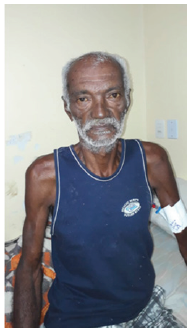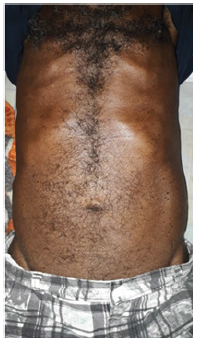Case Report 
 Creative Commons, CC-BY
Creative Commons, CC-BY
Gastric Adenocarcinoma: A Case Report
*Corresponding author: Brian França dos Santos, Gastroenterology and Digestive System, Surgery Academic League at Iguaçu University, Brazil
Received: March 31, 2020;Published: April 08, 2020
DOI: 10.34297/AJBSR.2020.08.001280
Introduction
Gastric cancer is one of the most common malignant tumors, being the leading cause of reported deaths in some countries. and the second most common cause of cancer-related deaths in the world. The most common histological type is gastric adenocarcinoma that corresponds for approximately 95% of the case [1]. The most well-known risk components for gastric cancer include biological, sociodemographic, lifestyle habits, environmental factors, drug use, family history and pre-existing disease. A large body of evidence supports a causal role of Helicobacter pylori in the majority of gastric malignancies and infections.
Methods
The data was obtained from collecting information by anamnesis from the patient medical record at Hospital Geral de Nova Iguaçu, in addition to laboratory tests and other images relevant to this study. And the images were collected along with the Hospital’s Radiology Department after the term of responsibility was signed.
Case Report
D.S.C., male, 65 years-old, mechanic, married, lives in Nova Iguaçu, state of Rio de Janeiro. The patient mentions pain that started four months ago on his mesogastrium and hypogastric with the manifestation of palpable mass on his mild periumbilical area. In addition to recurring episodes of intestinal constipation that lasted for approximately one week. He reported soft faeces and acholia. And also, specifically refers pre-cordialgia during meals. He also reported an important ponderal loss of more than 20 kilos during this period (Figure A,B).
He denied diabetes, high blood pressure, drug use and alcoholism. About familiar story his mother died of esophageal cancer and his father died of cardiovascular events. The patient had smoked twenty cigarettes per day during fifty-three years [2-9].
Discussion
Literature data demonstrates that the highest prevalence of this cancer occurs in males. Considering that the mortality in men is always higher than in women and that the survival rate in adenocarcinoma cases is low, especially when it’s not diagnosed early [10], it’s possible to infer that the most severe and lethal cases happened in males.
In terms of age, literature revealed an average age of 50,5 years old, which can be considered young, and the higher age revealed was 68 years old. It’s also relevant the cases of neoplasia in young ages, which was revealed to be from 28 years old. It reinforces the theory that cancer has been occurring increasingly in younger age groups. Since the stomach cancer takes approximately 20 years to get to its severe stage, from a pre-cancerous lesion [11], certainly the early-stage disease in studied individuals must have been occurred between the third and fourth life decade [12].
When asked about consuming alcohol and smoking, the patient of the case report declared he was not alcoholic but he was a smoker. It emphasizes the role of cigarettes as a strong inductor to general neoplasias, specially the stomach neoplasia [13-17]. Aside from being a risk factor for neoplasias, smoking is directly associated to cardiovascular diseases that exceed neoplasia in terms of hospitalizations [14,17].
Regarding treatment, in cases of gastric tumors, only radiotherapy (RT) is generally used. Although, it is still considered a secondary treatment method for gastric tumors [19]. According to Laporte and contributors [19], the surgical procedures acts as gold standard in most cases. However, in some situations, when associating chemotherapy sessions (QT) and RT in the same cycle of treatment, usually the treatment is more efficient. When used in an exclusive way, the RT shows itself as less efficient, but it keeps being recommended because it causes fewer debilitating effects to the patient, when compared to the treatment with QT [20].
The gastric tumors’ RT has the purpose of relieving pain and other symptoms, even though it does not provide high success with increasing survival rates. The gastric tumor presents resistance to radiotherapy treatment, being necessary, in most cases, increasing radiation doses, consequently, it may reach surrounding structures, like the intestinal mucosa, liver and spinal cord [21].
On account of this harmful consequence, in some cases, it occurs a dispensation of radiotherapy treatment [22]. Taking into consideration this factor, many studies have pointed out the need and importance of using the Intensity Modulated Radiation Therapy (IMRT), since the treatments derivative of this technology shows benefits and possibilities of delivering more accurate doses, resulting in the decrease of side effects, when compared to the actual effects in the conventional modality (2D) and conformational (3D) [23-24].
In this context, the tumor diagnoses in initial stages are of maximum importance, since it increases the chances of significant raise in patient survival rate. Although, it is common patients with gastric tumor in initial stages revealing as asymptomatic, being later diagnosed and finally receiving post-surgical indication of chemotherapy and/or radiotherapy. Unfortunately, in Brazil, gastric cancer cases are still not very well known, so the data collected are usually estimate. Therefore, it becomes important the creation of an orientation guide for gastric cancer in Brazil, taking into consideration the necessity of clarity and accuracy of information [21].
Review
Nearly seven million deaths in the world have been attributed to cancer, being the second leading cause of death in adults in developed countries and it’s one of the three main cause of deaths in adults in developing countries (1). The gastric cancer is the fourth most common malignant tumor in men and the sixth in woman, being of a multifactorial character. In both genres, the incidence grows from 35 to 40 years old, although it has been noted a decrease in its incidence, the mortality rates remain high [21].
In Brazil, for each year of the 2018-2019 biennial, it is estimated 13,540 new cases of stomach cancer in men and 7,750 in women, that corresponds to an estimated risk of 13,11 new cases for every 100 thousand men and 7,32 for every 100 thousand women [3]. Its high lethality has been associated to late diagnosis is most cases [4].
The most well-known risk factors for gastric cancer include biological and environmental factors, lifestyle habits, drug use, family history and pre-existing disease. In addition to Helicobacter pylori infection, the consumption of sausage and smoked food, among other factors.
The prognosis and treatment are defined by the tumor location and staging, as well as the number of resected and affected lymph nodes. Its location is diversified, involving or not the esophagogastric junction, or rarely, invading the duodenum. It makes evident that more than 50% of patients with initial cancer can be cured when they’re totally resected, while proximal cancer can be cured in less than 20% of times, even in its initial staging. Nearly 50% of diagnosed cases already show advanced staging, with survival rates of five years between 20 to 30% [6,7]. Therefore, a better understanding of epidemiological aspects of gastric cancer can assist the development of well-planned prevention strategies, as seen in Japan. In this country, the epidemiological knowledge helped to determine actions for its screening, for example the periodic endoscopic exams [8].
Conclusion
The eradication of risk factors and the reinforcement of protection acts, as of an adequate diet and cutting off harmful habits like alcohol consuming and smoking, should be adopted as early as possible. Considering the knowledge about the causal chain and the interaction between determining factors and the gastric cancer – particularly the adenocarcinoma, it could be possible to review the policies, planning and management of health services for prevention and treatment to adopt the best possible therapeutic, with a better targeting of resources for more susceptible and/or vulnerable groups. It may incur in better cost-effectiveness actions aimed in this pathology. Especially based on measures of screening for this cancer in these subgroups.
References
- Silva BMD, Cunha LBB, Soriano RB, Ito D, Perez ACD, et al. (2017) Tumores gástricos sincrônicos: um relato de caso. Medicina (Ribeirão Preto) 50(6):382-389.
- Karimi P, Islami F, Anandasabapathy S, Freedman ND, Kamangar F (2014) Gastric Cancer: Descriptive Epidemiology, Risk Factors, Screening, and Prevention. Cancer Epidemiol Biomarkers Prev 23(5): 700–713.
- INCA, Instituto Nacional de Câncer, José Alencar Gomes da Silva (2017) Coordenação de Prevenção e Vigilância. Estimativa 2018: Incidência de Câncer no Brasil. Rio de Janeiro, INCA, Disponível.
- Hu B, Hajj EI, Sittler S, Lammert N, Barnes R, et al. (2012) Gastric cancer: Classification, histology and application of molecular pathology. J Gastrointest Oncol 3(3): 251-261.
- Zilberstein B, Malheiros C, Lourenço LG, Kassab P, Jacob CE, et al. (2013) Consenso brasileiro sobre câncer gástrico: diretrizes para o câncer gástrico no Brasil. ABCD Arq Bras Cir Dig, São Paulo 26(1): 2-6.
- Wang W, Li YF, Sun XW, Chen YB, Li W, et al. (2010) Prognosis of 980 patients with gastric cancer after surgical resection. Chin J Cancer 29(11): 923-30.
- Castria TB, Guindalini RSC (2018) Diffuse Gastric Cancer. 1st ed, São Paulo, Springer, USA.
- Mansfield PF (2011) Clinical features, diagnosis, and staging of gastric cancer. Last literature review. Kato M, Asaka M. Recent development of gastric cancer prevention. Jpn J Clin Oncol 42(11): 987-9420.
- Jie Ding, Sun B, Song P, Liu S, Chen H, et al. (2017) The application of enhanced recovery after surgery (ERAS)/fasttrack surgery in gastrectomy for gastric cancer: a systematic review and meta-analysis. Oncotarget 8(43): 75699-75711.
- Santos AS, Burchianti LC, Netto NA, Mazon VAP, Malheiros CA, et al. (2015) Adenocarcinoma gástrico. Arq Med Hosp Fac Cienc Med 60(1): 156-9.
- Sociedade Brasileira de Cancerologia – SBC. Câncer do Aparelho Digestivo, 2016. Disponível.
- Malta CD, Santos MAS, Stopa SR, Vieira JEB, Melo EA, et al. (2016) A cobertura da estratégia de Saúde da Família (ESF) no Brasil, segundo a Pesquisa Nacional de Saúde, 2013. Ciênc saúde coletiva 21(2): 327-338.
- Godoy MF, Lucena JM, Miquelin AR, Flávia FP, Débora LQ, et al. (2007) Mortalidade por doenças cardiovasculares e níveis socioeconômicos na população de São José do Rio Preto, Estado de São Paulo, Brasil. Arq Bras Cardiol 88(2): 200-206.
- Wunsch Filho V, Antunes JLF, Boing AF, Lorenzi RL (2008) Perspectivas da investigação sobre determinantes sociais em câncer. Physis 18(3): 427-450.
- Ribeiro MSS, Silva JB, Oliveira KN, Meneses KF, Almeida SQP, et al. (2016) Óbitos por neoplasias na região sudoeste do estado da Bahia. Anais da 68ª Reunião Anual da SBPC.
- Friedenreich CM, Orenstein MR (2002) Physical activity and cancer prevention: etiologic evidence and biological mechanisms. J Nutr 132(11): 3456S-3464S.
- Guerra MR, Gallo CVM, Gulnar A, Mendonça S (2005) Risco de câncer no Brasil: tendências e estudos epidemiológicos mais recentes. Rev bras cancerol 51(3): 227-234.
- Sawada NO, Nicolussi AC, Okino L, Cardozo FMC, Zago MMF (2009) Avaliação da qualidade de vida de pacientes com câncer submetidos à quimioterapia. Rev Esc Enferm USP 43(3): 581-587.
- Laporte GA, Weston AC, Paludo AO, Kastria TB, Kalil AN (2014) Análise epidemiológica dos Adenocarcinomas Gástricos ressecados em um Serviço de Cirurgia Oncológica. AMRIGS 58(2): 121-125.
- Araujo DN, Dantas DS, Nascimento RSTR (2012) Efeitos do exercício físico em mulheres com câncer de mama submetidas à radioterapia: uma revisão sistemática. Arq Catarin Med 41(1): 78-82.
- Zilberstein B, Malheiros C, Lourenço LG, Kassab P, Jacob CE, et al. (2013) Consenso Brasileiro sobre câncer gástrico: diretrizes para o câncer gástrico no Brasil. ABCD arq bras Cir dig 26(1): 2-6.
- Toneto MG (2012) Estado atual do tratamento cirúrgico do adenocarcinoma gástrico avançado. ABCD arq bras Cir dig 56(1): 81-86.
- Brito D, Raimundo A, Sousa, Olga A, Pereira H, et al. (2014) Recomendações para o diagnóstico e tratamento do adenocarcinoma gástrico. Rev Port Cir 28(1): 45-56.
- Sawada NO, Dias AM, Zago DMF (2006) O efeito da radioterapia sobre a qualidade de vida dos pacientes com câncer de cabeça e pescoço. Rev Bras Cancerol 52(4): 323-329.





 We use cookies to ensure you get the best experience on our website.
We use cookies to ensure you get the best experience on our website.